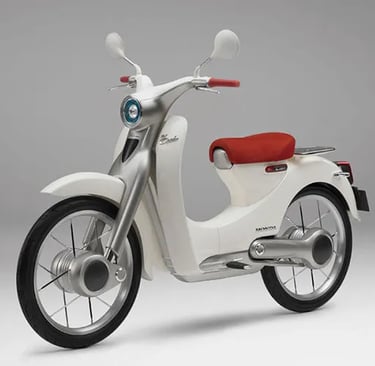Electrifying Existence: The Philosophical Odyssey of the Honda Super Cub and the Enigmatic Evolution into the EV-Cub
The article discusses the Honda Super Cub, a iconic motorcycle that has become a symbol of universal connectivity, and its evolution into the electric EV-Cub. It explores the philosophical aspects of the Super Cub and ponders the purpose and implications of electrifying this legendary motorcycle.
SCOOTERS HONDA ASIA ELECTRIC 2020'SJAPAN
11/14/20232 min read


Electrifying Existence: The Philosophical Odyssey of the Honda Super Cub and the Enigmatic Evolution into the EV-Cub
In the realm of existentialist musings on the mechanical world, behold the iconic Honda Super Cub, a philosophical paradox on two wheels. It is not a work of art by conventional standards, nor does it succumb to the reckless pursuit of speed that often defines its motorized counterparts. No, the Super Cub, with its humble 50cc kick-start engine, four horsepower, and a modest top speed of 50 mph, emerges as the silent sage, challenging the very essence of vehicular greatness.
In the grand theater of internal combustion, the Honda Super Cub reigns supreme, having transcended the limitations of brute power and ostentatious design. The numerical testament to its dominance is staggering—over 60 million units sold. This inconspicuous machine, born in 1958, has weathered the storms of time, evolving from a mere mode of transport to a symbol of universal connectivity, epitomized by the resonant slogan, "You meet the nicest people on a Honda."
As the wheels of time turn relentlessly, Honda, the guardian of this mechanical philosopher, introduces a perplexing twist to the narrative—an electric metamorphosis known as the EV-Cub. Unveiled at the Tokyo Auto Show, this two-wheel-drive marvel carries the weight of history on its battery-laden shoulders. The design, a subtle dance of modernity with echoes of 1958, beckons contemplation on progress and nostalgia, blurring the boundaries between past and future.
Honda, in its customary enigmatic fashion, offers scant details on the EV-Cub, merely stating its intent to be as "functional and convenient" as its venerable predecessor. Here lies the existential quandary: Does the pursuit of electrification in a motorcycle that achieved an astounding 282 miles per gallon in its combustion incarnation make rational sense? Is there a deeper purpose, a cosmic efficiency waiting to be unraveled, or are we merely witnessing the whims of progress, indifferent to the simplicity that once defined the Super Cub?
The electric Cub, an emissary from a future where the whirr of motors is replaced by the hum of electrons, invites scrutiny. Is it a practical evolution, or a deviation from the inherent simplicity that made the Super Cub an unwavering companion for countless riders? The answers, like existential inquiries, remain elusive.
In the face of skepticism, one must acknowledge the audacity of Honda. The electro-Cub, with its silent glide through the modern landscape, challenges our perceptions of affordable electric vehicles. It embodies the spirit of existential rebellion, a deviation from the expected, yet a testament to the inexorable march of innovation.
As we navigate this philosophical landscape on two wheels, the Super Cub, now clad in electric armor, beckons us to ponder the dichotomy of progress and tradition. Will this new chapter resonate with riders seeking the essence of a motorcycle, or shall it remain a mere curiosity in the annals of vehicular evolution? The answers, my fellow wanderers, lie in the existential ride that awaits, as the Super Cub, in its electric guise, continues to challenge the very fabric of our mechanical existence.
